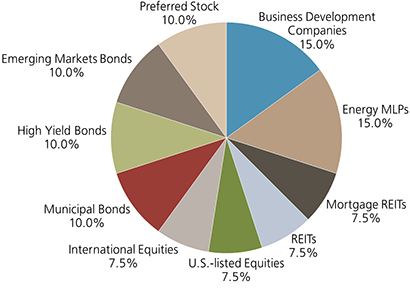UBS (UBS) rolled out the ETRACS Diversified High Income ETN (DVHI) on Thursday (9/19/13). The new exchange traded note (“ETN”) is targeted at investors desiring significant monthly income from a diversified multi-asset mix. It will track the new NYSE Diversified High Income Index minus the 0.84% annual tracking fee. The underlying index has a current yield of 7.7%, and the ETN will make monthly cash distributions.
The underlying NYSE Diversified High Income Index measures the performance of a diversified basket of 138 publicly-traded securities that historically pay significant dividends or distributions. Index features and construction aim to highlight income while seeking to reduce price volatility. The methodology incorporates minimum free float market capitalization, dividend yield, and liquidity while including asset class and sector weighting restrictions. The index rebalances quarterly to maintain the target sector weightings. The index was created August 20, 2013 and, therefore, has only one-month of performance history.
 Target sector allocations of the index are illustrated below and encompass a wide range of asset classes. The stock/bond allocations are nominally at 70%/30%, and international exposure is estimated at 11% of the equity exposure and 33% of the bond holdings.
Target sector allocations of the index are illustrated below and encompass a wide range of asset classes. The stock/bond allocations are nominally at 70%/30%, and international exposure is estimated at 11% of the equity exposure and 33% of the bond holdings.
The underlying index has 138 constituents with the largest allocations going to PowerShares Emerging Markets Sovereign Debt (PCY) 10.0%, iShares iBoxx $ High Yield Corporate Bond ETF (HYG) 9.9%, iShares US Preferred Stock ETF (PFF) 7.0%, Market Vectors High Yield Municipal Index ETF (HYD) 4.9%, Ares Capital (ARCC) 4.2%, and Energy Transfer Partners LP (ETP) 4.0%.
Additional information is located in the overview, fact sheet (pdf), and prospectus supplement (pdf).
Analysis/Opinion: UBS has come a long way since the time nine of its ten products were part of the January 2009 ETF Deathwatch. In past years, you could count on me to be highly critical of nearly every new ETRACS that came to market, such as my “Are You Ready for More E-TRACS?” article from November 2009. Today, I consider the UBS ETRACS lineup to be one of, if not the, most innovative and complete ETN offerings. DVHI reinforces my improved perception of the ETRACS brand.
The DVHI fact sheet (pdf) is the most informative, most complete, and best summary of a new ETP I have seen this year. It succinctly describes the target asset class allocations, top holdings, indexing methodology, and key features. It doesn’t try to hide the risks and shortcomings. Instead, it includes the ETN disclosures on the front page instead of buried in the small print and even highlights the fact the index was created just a month ago. Last but not least, the yield of the underlying index is presented, a key item of interest to the target audience of income investors that many other product providers seem to ignore.
The fact sheet also informs us investors will not receive the full 7.7% yield because it will be reduced to cover investor fees and any withholding taxes. Therefore, I estimate the ETN’s yield, based on the September 13 data, will be about 6.8%. This is very attractive for the current environment, especially considering its 70%/30% stock/bond mix. However, I expect DVHI to have significant volatility because of the asset classes included. Business Development Companies, mortgage REITs, and international equities are quite volatile as are the emerging market and high yield bond allocations. Diversification can only go so far.
Many of the index constituents include other ETFs and ETNs. However, since their fees and expenses are included in the index calculations, the DVHI ETN does not have to report any “acquired fund fee” expenses like most other fund-of-funds are required to do.
Diversified multi-asset income ETF competitors include Guggenheim Multi-Asset Income (CVY) currently yielding 5.8%, iShares Morningstar Multi-Asset Income (IYLD) 6.1%, First Trust Multi-Asset Diversified Income (MDIV) 6.9%, and the actively managed SPDR SSgA Multi-Asset Income Allocation (INKM) with a 4.1% yield.
Bottom line: If you are looking for high current income versus income growth and can stomach the risk and volatility of the underlying asset classes, then DVHI should be on your list.
Disclosure covering writer, editor, and publisher: Long PCY. No positions in any of the companies or ETF sponsors mentioned. No income, revenue, or other compensation (either directly or indirectly) received from, or on behalf of, any of the companies or ETF sponsors mentioned.